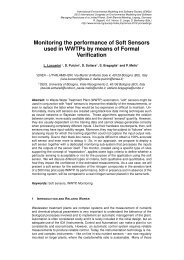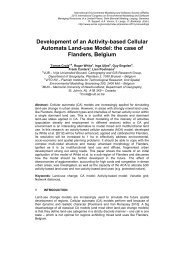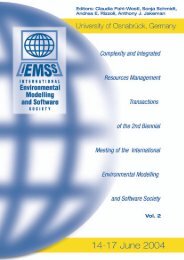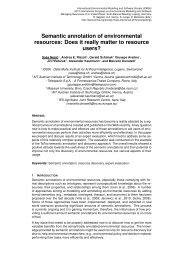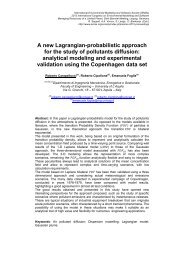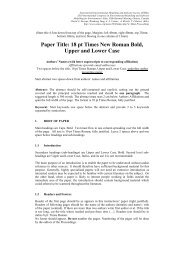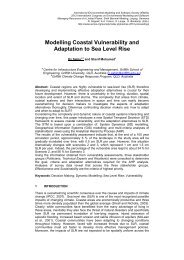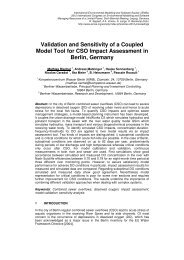Linked Data in Renewable Energy Domain - International ...
Linked Data in Renewable Energy Domain - International ...
Linked Data in Renewable Energy Domain - International ...
Create successful ePaper yourself
Turn your PDF publications into a flip-book with our unique Google optimized e-Paper software.
<strong>International</strong> Environmental Modell<strong>in</strong>g and Software Society (iEMSs)<br />
2012 <strong>International</strong> Congress on Environmental Modell<strong>in</strong>g and Software<br />
Manag<strong>in</strong>g Resources of a Limited Planet, Sixth Biennial Meet<strong>in</strong>g, Leipzig, Germany<br />
R. Seppelt, A.A. Vo<strong>in</strong>ov, S. Lange, D. Bankamp (Eds.)<br />
http://www.iemss.org/society/<strong>in</strong>dex.php/iemss-2012-proceed<strong>in</strong>gs<br />
<strong>L<strong>in</strong>ked</strong> <strong>Data</strong> <strong>in</strong> <strong>Renewable</strong> <strong>Energy</strong> Doma<strong>in</strong><br />
a Henry Abanda and b Joseph Tah<br />
Oxford Institute for Susta<strong>in</strong>able Development<br />
Department of Real Estate and Construction<br />
Faculty of Technology, Design and Environment<br />
Oxford Brookes University, Oxford, OX3 0BP, UK<br />
a fabanda@brookes.ac.uk; b jtah@brookes.ac.uk<br />
Abstract: The vision of the Semantic Web is to build a global Web of data that<br />
l<strong>in</strong>ks different resources. To this end, the first step is to put data on the Web <strong>in</strong> the<br />
form that mach<strong>in</strong>es can naturally understand or convert to useful forms. This can<br />
be achieved through <strong>L<strong>in</strong>ked</strong> <strong>Data</strong> technology, an emerg<strong>in</strong>g publish<strong>in</strong>g paradigm <strong>in</strong><br />
which not only documents, but also data are l<strong>in</strong>ked over the Web. The ultimate<br />
goal underp<strong>in</strong>n<strong>in</strong>g <strong>L<strong>in</strong>ked</strong> <strong>Data</strong> is to enable different <strong>in</strong>dividuals and organisations<br />
to efficiently contribute and share data about different doma<strong>in</strong>s. Climate change<br />
impacts and/or energy scarcity are among the lead<strong>in</strong>g challenges that the<br />
<strong>in</strong>ternational community currently faces. The doma<strong>in</strong> of renewable energy (RE) is<br />
widely believed to be an <strong>in</strong>novative doma<strong>in</strong> that can contribute significantly <strong>in</strong><br />
overcom<strong>in</strong>g these challenges. Consequently, the <strong>in</strong>stitutionalisation of<br />
policies/strategies that can potentially lead to the uptake of RE technologies by<br />
various organisations is now too common. Employ<strong>in</strong>g <strong>L<strong>in</strong>ked</strong> <strong>Data</strong> paradigm <strong>in</strong><br />
manag<strong>in</strong>g knowledge provides opportunities for disparate organisations and people<br />
to efficiently learn and share knowledge about RE technologies, hence potentially<br />
lead<strong>in</strong>g to their applications <strong>in</strong> different projects by end-users. However, given the<br />
nascent nature of <strong>L<strong>in</strong>ked</strong> <strong>Data</strong> technology, knowledge on how it has been<br />
employed <strong>in</strong> manag<strong>in</strong>g RE knowledge is still very limited. In this paper, an<br />
exploration of the use of <strong>L<strong>in</strong>ked</strong> <strong>Data</strong> <strong>in</strong> the RE and its relationship to other <strong>L<strong>in</strong>ked</strong><br />
<strong>Data</strong> of different doma<strong>in</strong>s will be conducted. Given the scope of the study, an<br />
exploratory desk-study methodology has been pursued. Furthermore, two <strong>L<strong>in</strong>ked</strong><br />
<strong>Data</strong> applications have been discussed.<br />
Key words: <strong>L<strong>in</strong>ked</strong> <strong>Data</strong>; <strong>Renewable</strong> energy; Semantic Web<br />
1 BACKGROUND<br />
The current Web has been successful <strong>in</strong> provid<strong>in</strong>g <strong>in</strong>formation about different<br />
doma<strong>in</strong>s to different people <strong>in</strong> different regions of the world. Despite this success, it<br />
has been plagued by many short com<strong>in</strong>gs [Allemang and Hendler 2011]. One can<br />
easily get lost <strong>in</strong> search of <strong>in</strong>formation over the Web or does not even obta<strong>in</strong> the<br />
required and precise results. Key to this cause is the overwhelm<strong>in</strong>g disparate data<br />
be<strong>in</strong>g loaded over the Web by different end-users from different term<strong>in</strong>als. Thus,<br />
the idea of l<strong>in</strong>k<strong>in</strong>g data over the Web for efficient doma<strong>in</strong> knowledge management<br />
has emerged. This concept is generally called “<strong>L<strong>in</strong>ked</strong> <strong>Data</strong>”.<br />
Depend<strong>in</strong>g on different societal needs different research communities have<br />
developed l<strong>in</strong>ked dataset. Perhaps, partly because of the promises and<br />
opportunities <strong>in</strong> <strong>L<strong>in</strong>ked</strong> <strong>Data</strong> set and hence the Semantic Web, <strong>in</strong>terest <strong>in</strong> both has<br />
widely grown. Different agencies <strong>in</strong>clud<strong>in</strong>g government departments and renowned<br />
<strong>in</strong>stitutions have recently engaged <strong>in</strong> develop<strong>in</strong>g <strong>L<strong>in</strong>ked</strong> <strong>Data</strong> sets <strong>in</strong> different<br />
fields.
Abanda and Tah/ <strong>L<strong>in</strong>ked</strong> <strong>Data</strong> <strong>in</strong> <strong>Renewable</strong> <strong>Energy</strong> Doma<strong>in</strong><br />
Recently, climate change and energy scarcity have occupied the centre stage of<br />
most governments and <strong>in</strong>ternational organisations. The uptake of RE technologies<br />
has been among the top strategies <strong>in</strong> combat<strong>in</strong>g climate change and provid<strong>in</strong>g<br />
clean energy [Connolly et al. 2011; Deichmann 2011]. While advanced <strong>in</strong>formation<br />
technology <strong>in</strong>clud<strong>in</strong>g <strong>L<strong>in</strong>ked</strong> <strong>Data</strong> paradigm has been used <strong>in</strong> diffus<strong>in</strong>g knowledge<br />
about different doma<strong>in</strong>s such as life sciences, media and publications; little effort<br />
has been made towards l<strong>in</strong>k<strong>in</strong>g data <strong>in</strong> the RE doma<strong>in</strong>. Partly, this constituted the<br />
rationale of the studies conducted by Abanda [2011] and Tah and Abanda [2011]<br />
where they focused on <strong>in</strong>vestigat<strong>in</strong>g better ways of modell<strong>in</strong>g knowledge about<br />
susta<strong>in</strong>able build<strong>in</strong>g technology doma<strong>in</strong>. Furthermore, from an <strong>in</strong>dustry<br />
perspective, attempts are currently be<strong>in</strong>g made <strong>in</strong> develop<strong>in</strong>g some real RE<br />
datasets by reputable organisations. However, as earlier alluded to, RE datasets<br />
that exist are quite few compared to other fields despite its importance. Thus, more<br />
is needed <strong>in</strong> <strong>in</strong>vestigat<strong>in</strong>g better ways of develop<strong>in</strong>g RE datasets and l<strong>in</strong>k<strong>in</strong>g them<br />
to other datasets. The objectives of this study are to: a) establish the state-of-theart<br />
of <strong>L<strong>in</strong>ked</strong> <strong>Data</strong> about RE; b) determ<strong>in</strong>e to what extent RE data is l<strong>in</strong>ked to other<br />
doma<strong>in</strong> data; c) demonstrate the discovery of knowledge us<strong>in</strong>g <strong>L<strong>in</strong>ked</strong> <strong>Data</strong>; d)<br />
establish a research gap <strong>in</strong> relation to RE l<strong>in</strong>ked data research.<br />
Given the nascent nature of the <strong>L<strong>in</strong>ked</strong> <strong>Data</strong>, a desk-study was used to achieve<br />
these objectives. The focus has been on the literature sources published from<br />
2006 which corresponds to the time when the Semantic Web Education and<br />
Outreach Interest Group of World Wide Web Consortium was formed and<br />
entrusted with the task to develop strategies and materials to <strong>in</strong>crease awareness<br />
among the Web community of the need and benefit for the Semantic Web, and<br />
educate the Web community regard<strong>in</strong>g related solutions and technologies [SWEO<br />
2006], which <strong>in</strong> fact laid the groundwork for <strong>L<strong>in</strong>ked</strong> <strong>Data</strong> paradigm.<br />
2 OVERVIEW OF LINKED DATA<br />
2.1 <strong>L<strong>in</strong>ked</strong> <strong>Data</strong> philosophy<br />
In traditional Web, documents are accessed us<strong>in</strong>g Hypertext Markup Language<br />
(HTML) browsers. The end-user generally pursues the l<strong>in</strong>ks between HTML pages<br />
where a particular resource has been def<strong>in</strong>ed. Similarly, data <strong>in</strong> the Semantic Web<br />
can be accessed us<strong>in</strong>g <strong>L<strong>in</strong>ked</strong> <strong>Data</strong> browsers. <strong>L<strong>in</strong>ked</strong> <strong>Data</strong> refers to a style of<br />
publish<strong>in</strong>g and l<strong>in</strong>k<strong>in</strong>g structured data on the Web [Berners-Lee 2006]. The<br />
fundamental idea that underp<strong>in</strong>s <strong>L<strong>in</strong>ked</strong> <strong>Data</strong> is that value and usefulness of data<br />
are maximised when <strong>in</strong>terl<strong>in</strong>ked with other data. Thus, unlike HTML pages for the<br />
traditional Web, data sources are required for the Semantic Web.<br />
Similar to the navigation from one HTML document to the other which exploits the<br />
fact that some key words have been tagged and URI (Uniform Resource Identifier)<br />
referenced, the navigation between the different data sources over the Semantic<br />
Web is based on ontologies expressed <strong>in</strong> Resource Description Framework (RDF)<br />
[Heath and Bizer 2011]. RDF is by far the most mature data model that has been<br />
<strong>in</strong>tegrated <strong>in</strong>to many enabl<strong>in</strong>g Semantic Web technologies. RDF helps <strong>in</strong> mak<strong>in</strong>g<br />
statements about resources <strong>in</strong> the form of subject-predicate-object expressions.<br />
For example, <strong>in</strong> RDF, the notion “The PV-module has the colour of blue” is<br />
represented <strong>in</strong> the RDF “subject-predicate-object” paradigm as:<br />
“the PV-module” (subject), “has the colour” (predicate) and “blue” (object)<br />
In RDF, each resource is def<strong>in</strong>ed by an URI as well as the different components of<br />
the “subject-predicate-object” triples. Thus, <strong>L<strong>in</strong>ked</strong> <strong>Data</strong> browsers enable users to<br />
navigate between different data sources by pursu<strong>in</strong>g RDF l<strong>in</strong>ks. This allows the<br />
user to start with one data source and then move through a potentially endless<br />
Web of data sources connected by RDF l<strong>in</strong>ks [SWEO 2006]. For example,<br />
2
Abanda and Tah/ <strong>L<strong>in</strong>ked</strong> <strong>Data</strong> <strong>in</strong> <strong>Renewable</strong> <strong>Energy</strong> Doma<strong>in</strong><br />
suppose an end-user is search<strong>in</strong>g for “alum<strong>in</strong>ium frame system” over a<br />
hypothetical Semantic Web. The end-user might be <strong>in</strong>terested <strong>in</strong> the supplier’s<br />
location. By pursu<strong>in</strong>g an “alum<strong>in</strong>ium frame system” RDF l<strong>in</strong>k, the user can navigate<br />
to <strong>in</strong>formation about supplier’s location conta<strong>in</strong>ed <strong>in</strong> another dataset. In other<br />
words, let’s suppose “alum<strong>in</strong>ium frame system” is conta<strong>in</strong>ed <strong>in</strong> the ASC Complete<br />
Resource for the United K<strong>in</strong>gdom (UK) build<strong>in</strong>g products [ASC 2011]. The ASC<br />
Build<strong>in</strong>g Products Directory is one of the largest sources of <strong>in</strong>formation on build<strong>in</strong>g<br />
products and build<strong>in</strong>g materials <strong>in</strong> the UK construction market. It conta<strong>in</strong>s<br />
<strong>in</strong>formation about build<strong>in</strong>g products and their respective suppliers. Let’s also<br />
assume that the supplier’s <strong>in</strong>formation is found <strong>in</strong> the onl<strong>in</strong>e Yellow Pages<br />
Directory. The Yellow Pages Directory is a resource that conta<strong>in</strong>s <strong>in</strong>formation<br />
about bus<strong>in</strong>esses <strong>in</strong> the UK. By pursu<strong>in</strong>g the “alum<strong>in</strong>ium frame system” <strong>in</strong> the ASC<br />
directory, <strong>in</strong>formation about the alum<strong>in</strong>ium frame system and its supplier can be<br />
obta<strong>in</strong>ed. If by def<strong>in</strong>ition “supplier’s location” had a URI and also formed part of the<br />
RDF triples, it will be possible to pursue the RDF l<strong>in</strong>k to obta<strong>in</strong>ed more <strong>in</strong>formation<br />
about the supplier’s <strong>in</strong>formation <strong>in</strong> the Yellow Pages Directory. It is important to<br />
note that this is on the proviso that data stored <strong>in</strong> the Yellow Pages and ASC<br />
directories are <strong>in</strong> RDF format.<br />
2.2 Some l<strong>in</strong>k<strong>in</strong>g open data efforts<br />
Over the last five years, the research community has engaged <strong>in</strong> the development<br />
of <strong>L<strong>in</strong>ked</strong> <strong>Data</strong> <strong>in</strong> different doma<strong>in</strong>s. The <strong>L<strong>in</strong>ked</strong> <strong>Data</strong> that so far exist relates to the<br />
different geographical locations, people, companies, books, scientific publications,<br />
television, music, etc. The different <strong>L<strong>in</strong>ked</strong> <strong>Data</strong> of various doma<strong>in</strong>s and their<br />
different relations is represented as a data cloud presented <strong>in</strong> Figure 1.<br />
Government<br />
Geographic<br />
Media<br />
Cross-doma<strong>in</strong><br />
3<br />
User-generated<br />
Life sciences<br />
Figure 1. <strong>L<strong>in</strong>ked</strong> <strong>Data</strong> cloud [Source Bizer et al. [2011]]<br />
Publications<br />
From Figure 1, the different <strong>L<strong>in</strong>ked</strong> <strong>Data</strong> sources can be categorised <strong>in</strong>to seven<br />
ma<strong>in</strong> groups <strong>in</strong>clud<strong>in</strong>g life sciences, geographic data, media, user-generated<br />
content, publications, media and government. From Figure 1, statistics for the ma<strong>in</strong><br />
<strong>L<strong>in</strong>ked</strong> <strong>Data</strong> groups is presented <strong>in</strong> Table 1.
Abanda and Tah/ <strong>L<strong>in</strong>ked</strong> <strong>Data</strong> <strong>in</strong> <strong>Renewable</strong> <strong>Energy</strong> Doma<strong>in</strong><br />
Table 1. L<strong>in</strong>k<strong>in</strong>g open data set statistics, September 2011<br />
Doma<strong>in</strong> Number of<br />
datasets<br />
Triples % (Out-) L<strong>in</strong>ks %<br />
Media 25 1,841,852,061 5.82 50,440,705 10.01<br />
Geographic 31 6,145,532,484 19.43 35,812,328 7.11<br />
Government 49 13,315,009,400 42.09 19,343,519 3.84<br />
Publications 87 2,950,720,693 9.33 139,925,218 27.76<br />
Crossdoma<strong>in</strong><br />
41 4,184,635,715 13.23 63,183,065 12.54<br />
Life sciences 41 3,036,336,004 9.60 191,844,090 38.06<br />
Usergenerated<br />
content<br />
20 134,127,413 0.42 3,449,143 0.68<br />
295 31,634,213,770 503,998,829<br />
Source Bizer et al. [2011]<br />
3 WHY THE RENEWABLE ENERGY DOMAIN?<br />
The contribution of RE towards m<strong>in</strong>imis<strong>in</strong>g climate change impact and the<br />
amelioration of energy poverty cannot be understated. As of 2004 it was estimated<br />
that RE contributed about 14% of world energy [UNDP 2004] and reduces<br />
enormous amount of greenhouse gases that impacts on the environment.<br />
Consequently, many governments are now recommend<strong>in</strong>g the use of RE. To this<br />
effect, various voluntary and mandatory policies aimed at encourag<strong>in</strong>g the uptake<br />
of RE are now common. In the UK, feed-<strong>in</strong>-tariff and RE obligations are among the<br />
lead<strong>in</strong>g policies to promote their use [DECC 2011]. Thus, RE market is matur<strong>in</strong>g at<br />
an alarm<strong>in</strong>g rate on daily basis. In relation to the existence and application of RE, it<br />
is <strong>in</strong>terwoven with many other doma<strong>in</strong>s. Build<strong>in</strong>gs upon which RE is applied,<br />
policies that regulate its use, the <strong>in</strong>volvement of manufacturers and <strong>in</strong>stallers <strong>in</strong><br />
RE, location of manufacturers are doma<strong>in</strong>s related to RE <strong>in</strong> one way or the other.<br />
This makes RE a suitable area to <strong>in</strong>vestigate its relationship with other doma<strong>in</strong>s.<br />
The key question is how is RE dataset l<strong>in</strong>ked to other doma<strong>in</strong>s?<br />
Despite the importance of RE vis-à-vis climate change and energy scarcity, it does<br />
not appear as a key concept <strong>in</strong> the L<strong>in</strong>k<strong>in</strong>g Open <strong>Data</strong> (LOD) cloud as depicted <strong>in</strong><br />
Table 1 and Figure 1. On further analysis it emerged that conventional energy and<br />
RE data have been captured under the “government” dataset. As <strong>in</strong> Table 1, the<br />
government dataset l<strong>in</strong>ks to other doma<strong>in</strong>s is only 3.84%, <strong>in</strong>dicat<strong>in</strong>g how weak the<br />
government dataset is l<strong>in</strong>ked to other doma<strong>in</strong> despite hav<strong>in</strong>g the highest “triples” or<br />
RDF l<strong>in</strong>ks. This implies RE has far fewer l<strong>in</strong>ks than the 3.84% as it is a subset of<br />
the government concept. Thus RE is an important and suitable area that warrants<br />
<strong>in</strong>vestigation with regards to the <strong>L<strong>in</strong>ked</strong> <strong>Data</strong> paradigm.<br />
4 OVERVIEW OF RE LINKED DATA<br />
Currently, the LOD cloud <strong>in</strong> Figure 1 constitutes the best source where RE RDF<br />
can be found. On explor<strong>in</strong>g the cloud, the follow<strong>in</strong>g l<strong>in</strong>ked RE RDF knowledge<br />
models were uncovered: a) OpenEI - Open <strong>Energy</strong> Info.: This is a platform that<br />
connects world energy data; b) European Environment Agency Published<br />
Products: This consists of <strong>in</strong>dependent <strong>in</strong>formation about the environment; c)<br />
<strong>L<strong>in</strong>ked</strong> Clean <strong>Energy</strong> <strong>Data</strong> (reegle.<strong>in</strong>fo): This is l<strong>in</strong>ked clean energy dataset which<br />
is comprised of policy and regulatory country profiles, key stakeholders<br />
(organisation profiles), project outcome documents and a thesaurus on<br />
renewables, energy efficiency and climate change for public re-use.<br />
4
Abanda and Tah/ <strong>L<strong>in</strong>ked</strong> <strong>Data</strong> <strong>in</strong> <strong>Renewable</strong> <strong>Energy</strong> Doma<strong>in</strong><br />
While the above RE datasets might be related or are l<strong>in</strong>ked, it will be more<br />
important to extend the l<strong>in</strong>k to <strong>in</strong>clude other related concepts. These concepts may<br />
be datasets that provide the different stakeholders <strong>in</strong>volved <strong>in</strong> RE energy bus<strong>in</strong>ess,<br />
country <strong>in</strong> which the RE bus<strong>in</strong>ess is tak<strong>in</strong>g place, and even the datasets for cost<br />
and emissions from RE systems.<br />
5 RE LINKED DATA APPLICATIONS<br />
The examples of RE <strong>L<strong>in</strong>ked</strong> <strong>Data</strong> discussed <strong>in</strong> section 4 require that <strong>in</strong>formation<br />
about the different doma<strong>in</strong> be def<strong>in</strong>ed <strong>in</strong> a structured format, i.e. <strong>in</strong> RDF <strong>in</strong><br />
particular. But there are already exist<strong>in</strong>g <strong>in</strong>formation over the current Web which<br />
end-users are <strong>in</strong>terested <strong>in</strong> exploit<strong>in</strong>g. Thus, the development of <strong>L<strong>in</strong>ked</strong> <strong>Data</strong><br />
browsers that can be used <strong>in</strong> acquir<strong>in</strong>g <strong>in</strong>formation from the Web is ga<strong>in</strong><strong>in</strong>g ground.<br />
These browsers can be used <strong>in</strong> the construction of powerful “datameshups” across<br />
heterogeneous data source collections without requir<strong>in</strong>g any programm<strong>in</strong>g<br />
experience [ODE 2012]. Some ma<strong>in</strong> browsers are Marbles RDF browser, Zitgist<br />
RDF browser, OpenL<strong>in</strong>k <strong>Data</strong> Explorer previously known as OpenL<strong>in</strong>k RDF<br />
browser, Disco Hyperdata browser, Fenfire RDF browser and Tabulator. While<br />
most of the Semantic Web browsers have been developed to <strong>in</strong>terface with data<br />
sources, the OpenL<strong>in</strong>k <strong>Data</strong> Explorer and Tabulator are generic browsers that can<br />
be used to browse RDF data on the Web [Berners Lee et al. 2006]. In the ensu<strong>in</strong>g<br />
section, applications for the brows<strong>in</strong>g or f<strong>in</strong>d<strong>in</strong>g RE energy <strong>in</strong>formation us<strong>in</strong>g<br />
<strong>L<strong>in</strong>ked</strong> <strong>Data</strong> will be exam<strong>in</strong>ed. The first application explores structured <strong>L<strong>in</strong>ked</strong><br />
Clean <strong>Energy</strong> <strong>Data</strong> (reegle.<strong>in</strong>fo) (i.e. a RE <strong>L<strong>in</strong>ked</strong> <strong>Data</strong> example discussed <strong>in</strong> 4),<br />
while the second explores already exist<strong>in</strong>g RE <strong>in</strong>formation on the Web.<br />
5.1 Explor<strong>in</strong>g structured RDF RE <strong>L<strong>in</strong>ked</strong> Open <strong>Data</strong> from Reegle website<br />
RE is a key concept <strong>in</strong> the <strong>L<strong>in</strong>ked</strong> Clean <strong>Energy</strong> <strong>Data</strong>set. Its graphical presentation<br />
facilitates navigation to other related concepts. The symbol R denotes “related”<br />
terms. For example, “renewable energies” is “related” to “energy”. On the other<br />
hand N denotes “broader” or “narrower” terms. For example, “renewable energies”<br />
is a “broader” term to “renewable energy sources”. Reegle website provides a<br />
facility to generate RE RDF format through a s<strong>in</strong>gle click. An excerpt of the output<br />
from click<strong>in</strong>g “renewable energies” is presented on the right of Figure 2.<br />
Figure 2. <strong>Renewable</strong> energies <strong>L<strong>in</strong>ked</strong> <strong>Data</strong> [Source Reegle [2011]]<br />
5
Abanda and Tah/ <strong>L<strong>in</strong>ked</strong> <strong>Data</strong> <strong>in</strong> <strong>Renewable</strong> <strong>Energy</strong> Doma<strong>in</strong><br />
Based on the left of Figure 2, it is possible to determ<strong>in</strong>e development <strong>in</strong>stitutions<br />
<strong>in</strong>volved <strong>in</strong> “renewable energies”. This can be achieved by simple clicks on desired<br />
concepts as depicted <strong>in</strong> Figure 3. First, “renewable energies” concept is clicked.<br />
Second, “<strong>International</strong> <strong>Energy</strong> Agency” is clicked. Lastly, “development <strong>in</strong>stitutions”<br />
is clicked and the different <strong>in</strong>stitutions <strong>in</strong>volved <strong>in</strong> RE then emerge as shown on the<br />
right of Figure 3. It is important to note that the RDF format of the different<br />
concepts <strong>in</strong> Figure 3 can easily be generated from Reegle’s website.<br />
Figure 3. Navigat<strong>in</strong>g RE <strong>in</strong>formation <strong>in</strong> REEGLE dataset<br />
5.2 EXPLORING RE DATA USING OpenL<strong>in</strong>k DATA EXPLORER<br />
Without any bias, OpenL<strong>in</strong>k <strong>Data</strong> Explorer, one of the lead<strong>in</strong>g <strong>L<strong>in</strong>ked</strong> <strong>Data</strong><br />
browsers will be used <strong>in</strong> explor<strong>in</strong>g RE <strong>in</strong>formation from a non-structured or non-<br />
RDF website. OpenL<strong>in</strong>k <strong>Data</strong> Explorer is a <strong>L<strong>in</strong>ked</strong> <strong>Data</strong> browser plug-<strong>in</strong> currently<br />
available for Firefox, Safari and Google Chrome [ODE 2012]. It facilitates the<br />
exploration of raw data and data relationships that underly a Web page. The plug<strong>in</strong><br />
allows end-users to navigate between hypertext and hyperdata on the Web. The<br />
<strong>in</strong>stallation of the OpenL<strong>in</strong>k <strong>Data</strong> Explorer has been discussed <strong>in</strong> ODE [2012], and<br />
will not be repeated <strong>in</strong> this paper. However, it is important to note that for this<br />
example, it was <strong>in</strong>corporated <strong>in</strong>to Firefox. The steps are:<br />
A RE Web page is open from any Web l<strong>in</strong>k. In order to call the RE Web page <strong>in</strong>to<br />
OpenL<strong>in</strong>k <strong>Data</strong> Explorer, the RE Web page is right-clicked and “View Page<br />
Description” is selected as shown <strong>in</strong> Figure 4.<br />
Figure 4. Open<strong>in</strong>g a RE Web page <strong>in</strong> OpenL<strong>in</strong>k <strong>Data</strong> Explorer<br />
6
Abanda and Tah/ <strong>L<strong>in</strong>ked</strong> <strong>Data</strong> <strong>in</strong> <strong>Renewable</strong> <strong>Energy</strong> Doma<strong>in</strong><br />
From Figure 4, another representation of RE object is via the “primary topic”. On<br />
click<strong>in</strong>g on the RE object captured as “primary topic” <strong>in</strong> Figure 4, Figure 5 is<br />
obta<strong>in</strong>ed.<br />
Figure 5. <strong>Data</strong> object representation of RE<br />
One ma<strong>in</strong> advantage of OpenL<strong>in</strong>k <strong>Data</strong> Explorer is that it provides various views of<br />
any doma<strong>in</strong> knowledge for easy understand<strong>in</strong>g and visualisation. It also provides<br />
<strong>in</strong>terfaces that can easily be queried. This is provided through the “Alternative<br />
<strong>L<strong>in</strong>ked</strong> <strong>Data</strong> Views” as shown <strong>in</strong> Figure 5. On click<strong>in</strong>g on the facets l<strong>in</strong>k on the<br />
“Alternative <strong>Data</strong> Views” the different RE attributes are presented as <strong>in</strong> Figure 6.<br />
Figure 6. Presentation of RE attributes us<strong>in</strong>g Alternative <strong>L<strong>in</strong>ked</strong> <strong>Data</strong> Views<br />
6 CONCLUSION AND FURTHER RESEARCH<br />
In this paper the rationale for the need of <strong>L<strong>in</strong>ked</strong> <strong>Data</strong> <strong>in</strong> the RE doma<strong>in</strong> has been<br />
discussed. It emerged that current research <strong>in</strong> <strong>L<strong>in</strong>ked</strong> <strong>Data</strong> development <strong>in</strong> the RE<br />
field is lagg<strong>in</strong>g beh<strong>in</strong>d other fields. However, some important RE l<strong>in</strong>ked datasets<br />
already exist and there is need to extend them so that it can be made more useful<br />
for communities <strong>in</strong>terested <strong>in</strong> RE. While current RE datasets may not be much<br />
compared to datasets from other doma<strong>in</strong>s, <strong>in</strong> its current size it is a good start<strong>in</strong>g<br />
po<strong>in</strong>t for how it can be best explored for <strong>L<strong>in</strong>ked</strong> <strong>Data</strong> development and <strong>in</strong>tegration<br />
7
Abanda and Tah/ <strong>L<strong>in</strong>ked</strong> <strong>Data</strong> <strong>in</strong> <strong>Renewable</strong> <strong>Energy</strong> Doma<strong>in</strong><br />
with other datasets. This entails l<strong>in</strong>k<strong>in</strong>g most RE datasets to its related and needed<br />
doma<strong>in</strong>s so that <strong>in</strong>formation can easily be shared and re-used. This will be<br />
considered as part of future research.<br />
REFERENCES<br />
Abanda, F.H., Knowledge modell<strong>in</strong>g of emerg<strong>in</strong>g technologies for susta<strong>in</strong>able<br />
build<strong>in</strong>g development, Ph.D. thesis, Faculty of Technology, Design and<br />
Environment, Oxford Brookes University, Oxford, 2011.<br />
Allemang, D. and , J. Hendler, Semantic Web for the Work<strong>in</strong>g Ontologist: Effective<br />
Model<strong>in</strong>g <strong>in</strong> RDFS and OWL, Morgan Kaufmann, 384 pp., USA, 2011.<br />
ASC, The Complete Build<strong>in</strong>g Products & Build<strong>in</strong>g Materials Resource <strong>in</strong> the UK,<br />
http://www.asc<strong>in</strong>fo.co.uk/, 2011, accessed September 2011.<br />
Berners-Lee, <strong>L<strong>in</strong>ked</strong> <strong>Data</strong>, http://www.w3.org/DesignIssues/<strong>L<strong>in</strong>ked</strong><strong>Data</strong>.html, 2006,<br />
accessed September 2011.<br />
Berners-Lee, T., Y., Chen, L., Chilton, D., Connolly, R., Dhanaraj, J., Hollenbach,<br />
A., Lerer, D., and Sheets, Tabulator: Explor<strong>in</strong>g and analyz<strong>in</strong>g l<strong>in</strong>ked data<br />
on the semantic web, paper presented at the 3 rd <strong>International</strong> Semantic<br />
Web User Interaction Workshop, Georgia, USA, November 6, 2006.<br />
Bizer, C., A., Jentzsch, and R., Cyganiak, State of the LOD cloud,<br />
http://www4.wiwiss.fu-berl<strong>in</strong>.de/lodcloud/state/, accessed December 2011.<br />
Connolly, D., H., Lund, B.V., Mathiesen and M., Leahy, The first step towards a<br />
100% renewable energy-system for Ireland, Applied <strong>Energy</strong>, 88 (2), 502-<br />
507, 2011.<br />
DECC,Feed-In-Tariffs,<br />
http://www.decc.gov.uk/en/content/cms/meet<strong>in</strong>g_energy/renewable_ener/f<br />
eed<strong>in</strong>_tariff/feed<strong>in</strong>_tariff.aspx, accessed December 2011.<br />
Deichmann, U., C., Meisner, S., Murray and D., Wheeler, The economics of<br />
renewable energy expansion <strong>in</strong> rural Sub-Saharan Africa, <strong>Energy</strong> Policy,<br />
39 (1), 215-227, 2011.<br />
Heath, T. and C., Bizer, <strong>L<strong>in</strong>ked</strong> <strong>Data</strong>: Evolv<strong>in</strong>g the Web <strong>in</strong>to a Global <strong>Data</strong> Space.<br />
Synthesis Lectures on the Semantic Web: Theory and Technology,<br />
Morgan & Claypool, 138 pp., 2011.<br />
ODE, The OpenL<strong>in</strong>k <strong>Data</strong> Explorer Extension, http://ode.openl<strong>in</strong>ksw.com/,<br />
accessed February 2012.<br />
Reegle, Geothermal energy, http://www.reegle.<strong>in</strong>fo/glossary/500/geothermalenergy.htm<br />
, accessed December 2011.<br />
SWEO, SWEO L<strong>in</strong>k<strong>in</strong>g Open <strong>Data</strong> Community Project,<br />
http://l<strong>in</strong>keddata.jiscpress.org/sweo-l<strong>in</strong>k<strong>in</strong>g-open-data-communityproject/#2,<br />
accessed September 2011.<br />
Tah, J.H.M. and F.H., Abanda, Susta<strong>in</strong>able build<strong>in</strong>g technology knowledge<br />
representation: Us<strong>in</strong>g Semantic Web techniques, Journal of Advanced<br />
Eng<strong>in</strong>eer<strong>in</strong>g Informatics, 25 (3), 547-558, 2011.<br />
UNDP, World energy assessment: Overview 2004 update,<br />
http://www.undp.org/energy/docs/WEAOU_full.pdf., 2004, accessed 2012.<br />
8



